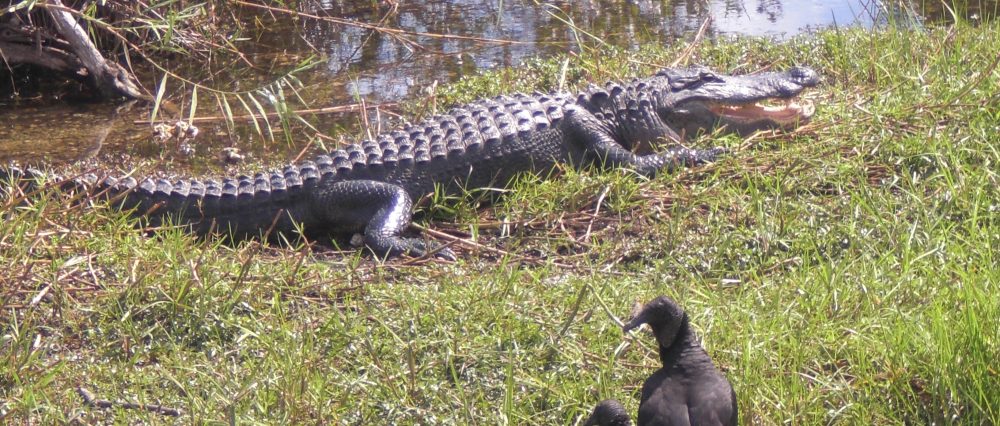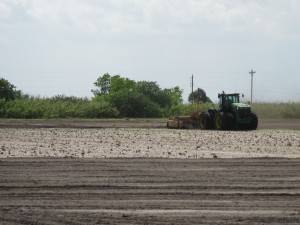
Fire is a tool used in harvesting sugar cane at U.S. Sugar Corp. outside of Clewiston, Fla. — Photo by Gwendolyn Craig
Big Sugar and the Everglades strive to survive together
By Courtney Robishaw
A truck moves along the perimeter of a field of thick dark green sugar cane that sprouts up to 12-feet tall, spraying accelerant as it passes. Smoke rises. Yellow and orange flames arise. Crunching and crackling are heard for 20 minutes until suddenly the fire dies out and only blackened smoky cane remains ready for harvest.
This powerful blaze at a field owned by U.S. Sugar Corp. is symbolic of the power of the South Florida company and its influence on the Florida Everglades.
U.S. Sugar is one of the prime sugar cane growers in the agricultural district just south of Lake Okeechobee. Here the sugar many Americans use is grown in rich “black gold” soil comprised of organic plant material. But U.S. Sugar is often is often in conflict with pro-environmental groups, because growing sugar produces minerals, most notably phosphorus, which pollutes the Everglades.
“U.S. Sugar is interested in fixing the problem,” said Judy Sanchez, senior director of corporate communications and public affairs for the company. We are interested in doing “as many best practices as we can.”
At one point it looked like U.S. Sugar might get out of the business of growing sugar cane. In a deal first proposed in 2008 by Gov.Charlie Crist, U.S. Sugar sold 27,000 acres of its land to the state of Florida for restoration. The deal was originally supposed to be 187,000 acres, but less land was sold because of the downturn in the economy. A contract option remains to sell the rest of their land, approximately 150,000 acres, to the state over ten years.
However, Sanchez, is not optimistic about the sale actually going through.
Many would be disheartened if that happened, like Larry Perez, a science communications interpreter at Everglades National Park.
“God knows that was a hard fought battle to begin with, just to get the relatively small amount of land that we’ve wound up getting for restoration, so that would set us back,” he said.
Since 1994, farmers have been required to reduce their impact on the environment, especially in cutting phosphorous levels by at least 25 percent. The average reduction since then has been at 50 percent and last year, phosphorus was reduced by 79 percent in the Everglades, according to Sanchez.
However, some like Paul Gray, a scientist and Lake Okeechobee specialist for the Audubon Society, worry that not enough is being done because the volume of contaminants keeps rising.
“Every year, we are making the phosphorus problem worse and worse and hope it gets better,” he said. “Agriculture has to get more sophisticated with how they manage agricultural properties,” Gray added.
The Everglades historically has had very few minerals and when phosphorus is added to the water flowing out of the agricultural district it affects the vegetation, said Stuart Appelbaum, chief of the planning and policyd division of the U.S. Army Corps of Engineers in Florida.
For instance, the Arthur R. Marshall Loxahatchee National Wildlife Refuge, which is just downstream from the agricultural district, currently has a phosphorus level five times higher than it should be, according to Donatto Surratt, project manager for Loxahatchee’s water monitoring program.
Farmers such as U.S. Sugar say they are striving to reduce their impact.
Farmers are required by the South Florida Water Management District, if they want to move water in and out of canals, to come up with a numerical point system that creates a positive impact. The combination of best management practices a farm chooses must add up to 25 points, according to Sanchez.
“We implement most of the best management practices applicable to sugar cane and it is well over 25 points on most of our farms,” said Sanchez.
Spending $4 million to $5 million a year, U.S. Sugar implemented many of these best practices, including modifying pumping practices in order to prevent sediment in the soil from being pumped with the water as it moves off the farm.
U.S. Sugar waits to turn on its pumps until there is about an inch of water on the fields. They then turn them on slowly to prevent sediment, along with minerals, from being stirred up in the canals, according to Sanchez.
In the canals, U.S. Sugar also built hills and valleys so the sediment gets trapped, while water flows overhead. U.S. Sugar also lets weeds build up alongside canals to capture wind erosion, according to Sanchez.
U.S. Sugar also uses a technique known as laser leveling to make fields “table-top” level, because anytime soil or water is moved around, phosphorus is moved into the public water supply.
“Laser technology is not cheap, but is one way technology is assisting farmers in being more environmentally friendly,” Sanchez said.
“If you don’t move water, you’re not moving phosphorus,” she added.
U.S. Sugar also uses banding technology, a machine that realizes a small band of fertilizer at the bottom of the sugar cane crop instead of all over the field.
However, some, like Jonathan Ullman, senior field organizer for the Sierra Club, criticized U.S. Sugar’s efforts and say they need to do more in paying for the clean-up.
“The sugar industry needs to pay their fair share to clean the water and they’re not. They’re only paying, I believe, 14 percent of the cost,” said Ullman.
He added that the South Florida taxpayers pay for the majority of the clean-up.
While critics are concerned about the degree of pollution the farmers are creating, they are even more worried what might happen if the farmers left. While that seems far fetched, many note that the rich soil nurturing the sugar cane is slowly eroding away.
Said Melissa Martin, a senior ecologist at Loxahatchee Refuge. “There is no doubt we are losing significant amounts of soil,” she said.
The region could become so low that it becomes a big lake or at worst, it could be sold for development


